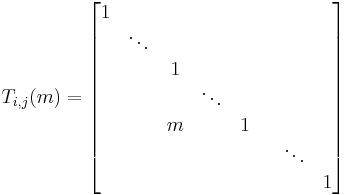Elementary matrix
In mathematics, an elementary matrix is a matrix which differs from the identity matrix by one single elementary row operation. The elementary matrices generate the general linear group of invertible matrices. Left multiplication (pre-multiplication) by an elementary matrix represents elementary row operations, while right multiplication (post-multiplication) represents elementary column operations.
In algebraic K-theory, "elementary matrices" refers only to the row-addition matrices.
Contents |
Use in solving systems of equations
Elementary row operations do not change the solution set of the system of linear equations represented by a matrix, and are used in Gaussian elimination (respectively, Gauss-Jordan elimination) to reduce a matrix to row echelon form (respectively, reduced row echelon form).
The acronym "ERO" is commonly used for "elementary row operations".
Elementary row operations do not change the kernel of a matrix (and hence do not change the solution set), but they do change the image. Dually, elementary column operations do not change the image, but they do change the kernel.
There are three types of (n x n) elementary matrices: 1) Permutation Matrix 2) Diagonal Matrix 3) Unipotent Matrix
Operations
There are three types of elementary matrices, which correspond to three types of row operations (respectively, column operations):
- Row switching
- A row within the matrix can be switched with another row.

- Row multiplication
- Each element in a row can be multiplied by a non-zero constant.

- Row addition
- A row can be replaced by the sum of that row and a multiple of another row.

The elementary matrix for any row operation is obtained by executing the operation on an identity matrix.
Row-switching transformations
This transformation, Tij, switches all matrix elements on row i with their counterparts on row j. The matrix resulting in this transformation is obtained by swapping row i and row j of the identity matrix.

- That is, Tij is the matrix produced by exchanging row i and row j of the identity matrix.
Properties
-
- The inverse of this matrix is itself: Tij−1=Tij.
- Since the determinant of the identity matrix is unity, det[Tij] = −1. It follows that for any conformable square matrix A: det[TijA] = −det[A].
Row-multiplying transformations
This transformation, Ti(m), multiplies all elements on row i by m where m is non zero. The matrix resulting in this transformation is obtained by multiplying all elements of row i of the identity matrix by m.
Properties
-
- The inverse of this matrix is: Ti(m)−1 = Ti(1/m).
- The matrix and its inverse are diagonal matrices.
- det[Ti(m)] = m. Therefore for a conformable square matrix A: det[Ti(m)A] = m det[A].
Row-addition transformations
This transformation, Tij(m), adds row j multiplied by m to row i. The matrix resulting in this transformation is obtained by taking row j of the identity matrix, and adding it m times to row i.
These are also called shear mappings or transvections.
Properties
-
- Tij(m)−1 = Tij(−m) (inverse matrix).
- The matrix and its inverse are triangular matrices.
- det[Tij(m)] = 1. Therefore, for a conformable square matrix A: det[Tij(1)A] = det[A].
- Row-addition transforms satisfy the Steinberg relations.
See also
- Gaussian elimination
- Linear algebra
- System of linear equations
- Matrix (mathematics)
- LU decomposition
References
- Axler, Sheldon Jay (1997), Linear Algebra Done Right (2nd ed.), Springer-Verlag, ISBN 0387982590
- Lay, David C. (August 22, 2005), Linear Algebra and Its Applications (3rd ed.), Addison Wesley, ISBN 978-0321287137
- Meyer, Carl D. (February 15, 2001), Matrix Analysis and Applied Linear Algebra, Society for Industrial and Applied Mathematics (SIAM), ISBN 978-0898714548, http://www.matrixanalysis.com/DownloadChapters.html
- Poole, David (2006), Linear Algebra: A Modern Introduction (2nd ed.), Brooks/Cole, ISBN 0-534-99845-3
- Anton, Howard (2005), Elementary Linear Algebra (Applications Version) (9th ed.), Wiley International
- Leon, Steven J. (2006), Linear Algebra With Applications (7th ed.), Pearson Prentice Hall

